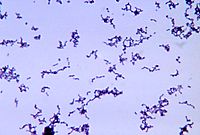
Photo from wikipedia
Hot and humid countries such as Indonesia have a higher prevalence of acne vulgaris (AV). The activity of skin microbes, not only Cutibacterium acnes, contribute to the formation of AV.… Click to show full abstract
Hot and humid countries such as Indonesia have a higher prevalence of acne vulgaris (AV). The activity of skin microbes, not only Cutibacterium acnes, contribute to the formation of AV. Topical and oral antibiotics are routinely prescribed to treat AV. As antimicrobial resistance rates increase globally, there are concerns about decreased efficacy. This study intends to systematically evaluate the microbiomes isolated from AV lesions and their antibiotics susceptibility in Indonesia. The data were retrieved through PubMed, EMBASE, Google Scholar, and ScienceDirect searches for articles published until July 2022 using three multiword searches. Sixteen studies published between 2001 and 2022 were identified from which the data were pooled using a random effects model. The pooled prevalence estimates demonstrated that C. acnes, Staphylococcus epidermidis, and Staphylococcus aureus were the three common microbes associated with AV in Indonesia. Tetracyclines had lower resistance rates compared to those of macrolides and clindamycin, with C. acnes showing a resistance rate that is as high as 60.1% against macrolides. C. acnes resistance against minocycline showed an increasing trend, whereas the resistances to doxycycline, clindamycin, and macrolides stagnated. The high resistance prevalence and trends signify a public health concern. The results of this study call for the development of antibiotic stewardship programs in Indonesia, which may lead to improved acne outcomes.
Journal Title: Antibiotics
Year Published: 2023
Link to full text (if available)
Share on Social Media: Sign Up to like & get
recommendations!